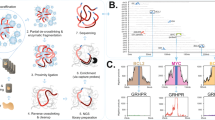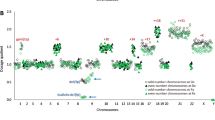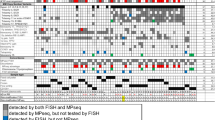Abstract
Three rearrangements in ALL disrupt E2A and create E2A fusion proteins: the t(1;19)(q23;p13) and E2A-PBX1, t(17;19)(q22;p13) and E2A-HLF and a cryptic inv(19)(p13;q13) and E2A-FB1. While E2A is fused to PBX1 in most ALLs with a t(1;19), 5–10% of cases have translocations that appear identical, but do not affect E2A or PBX1. Because more intensive therapy improves the outcome of patients with E2A-PBX1positive (1;19) translocations, it is critical to identify this subset of patients so that appropriate therapy can be administered. In addition, there are balanced and unbalanced variants of the t(1;19) and controversy exists regarding the clinical significance of this distinction. We have developed a two-color fluorescence in situhybridization assay that accurately detects E2A translocations in metaphase and interphase cells, distinguishes between balanced and unbalanced variants and identifies patients with a t(1;19) who lack E2A-PBX1 fusion. We found that clonal microheterogeneity is common in patients with E2A translocations and most patients have mixtures of cells with balanced and unbalanced translocations, suggesting that this distinction represents two ends of a continuum rather than distinct biological entities. These reagents should have widespread clinical utility and be useful for translational and basic research studies involving E2Atranslocations and this region of chromosome 19p13.
This is a preview of subscription content, access via your institution
Access options
Subscribe to this journal
Receive 12 print issues and online access
$259.00 per year
only $21.58 per issue
Buy this article
- Purchase on Springer Link
- Instant access to full article PDF
Prices may be subject to local taxes which are calculated during checkout


Similar content being viewed by others
References
Rabbitts TH . Chromosomal translocations in human cancer Nature 1994 372: 143–149
Pui CH . Childhood leukemias New Engl J Med 1995 332: 1618–1630
Carroll AJ, Crist WM, Parmley RT, Roper M, Cooper MD, Finley WH . Pre-B cell leukemia associated with chromosome translocation 1;19 Blood 1984 63: 721–724
Michael PM, Levin MD, Garson OM . Translocation 1;19 – a new cytogenetic abnormality in acute lymphocytic leukemia Cancer Genet Cytogenet 1984 12: 333–341
Mellentin JD, Murre C, Donlon TA, McCaw PS, Smith SD, Carroll AJ, McDonald ME, Baltimore D, Cleary ML . The gene for enhancer binding proteins E12/E47 lies at the t(1;19) breakpoint in acute leukemias Science 1989 246: 379–382
Nourse J, Mellentin JD, Galili N, Wilkinson J, Stanbridge E, Smith SD, Cleary ML . Chromosomal translocation t(1;19) results in synthesis of a homeobox fusion mRNA that codes for a potential chimeric transcription factor Cell 1990 60: 535–545
Kamps MP, Murre C, Sun XH, Baltimore D . A new homeobox gene contributes the DNA binding domain of the t(1;19) translocation protein in pre-B ALL Cell 1990 60: 547–555
Hunger SP, Galili N, Carroll AJ, Crist WM, Link MP, Cleary ML . The t(1;19)(q23;p13) results in consistent fusion of E2A and PBX1 coding sequences in acute lymphoblastic leukemias Blood 1991 77: 687–693
Privitera E, Kamps MP, Hayashi Y, Inaba T, Shapiro LH, Raimondi SC, Behm F, Hendershot L, Carroll AJ, Baltimore D et al. Different molecular consequences of the 1;19 chromosomal translocation in childhood B-cell precursor acute lymphoblastic leukemia Blood 1992 79: 1781–1788
Hunger SP, Ohyashiki K, Toyama K, Cleary ML . Hlf, a novel hepatic bZIP protein, shows altered DNA-binding properties following fusion to E2A in t(17;19) acute lymphoblastic leukemia Genes Dev 1992 6: 1608–1620
Inaba T, Roberts WM, Shapiro LH, Jolly KW, Raimondi SC, Smith SD, Look AT . Fusion of the leucine zipper gene HLF to the E2A gene in human acute B-lineage leukemia Science 1992 257: 531–534
Brambillasca F, Mosna G, Colombo M, Rivolta A, Caslini C, Minuzzo M, Giudici G, Mizzi L, Biondi A, Privitera E . Identification of a novel molecular partner of the E2A gene in childhood leukemia Leukemia 1999 13: 369–375
Crist WM, Carroll AJ, Shuster JJ, Behm FG, Whitehead M, Vietti TJ, Look AT, Mahoney D, Ragab A, Pullen DJ et al. Poor prognosis of children with pre-B acute lymphoblastic leukemia is associated with the t(1;19)(q23;p13): a Pediatric Oncology Group study Blood 1990 76: 117–122
Raimondi SC, Behm FG, Roberson PK, Williams DL, Pui CH, Crist WM, Look AT, Rivera GK . Cytogenetics of pre-B-cell acute lymphoblastic leukemia with emphasis on prognostic implications of the t(1;19) J Clin Oncol 1990 8: 1380–1388
Pui CH, Raimondi SC, Hancock ML, Rivera GK, Ribeiro RC, Mahmoud HH, Sandlund JT, Crist WM, Behm FG . Immunologic, cytogenetic, and clinical characterization of childhood acute lymphoblastic leukemia with the t(1;19) (q23; p13) or its derivative J Clin Oncol 1994 12: 2601–2606
Uckun FM, Sensel MG, Sather HN, Gaynon PS, Arthur DC, Lange BJ, Steinherz PG, Kraft P, Hutchinson R, Nachman JB, Reaman GH, Heerema NA . Clinical significance of translocation t(1;19) in childhood acute lymphoblastic leukemia in the context of contemporary therapies: a report from the Children's Cancer Group J Clinical Oncol 1998 16: 527–535
Shikano T, Kaneko Y, Takazawa M, Ueno N, Ohkawa M, Fujimoto T . Balanced and unbalanced 1;19 translocation-associated acute lymphoblastic leukemias Cancer 1986 58: 2239–2243
Secker-Walker LM, Berger R, Fenaux P, Lai JL, Nelken B, Garson M, Michael PM, Hagemeijer A, Harrison CJ, Kaneko Y, Rubin CM . Prognostic significance of the balanced t(1;19) and unbalanced der(19)t(1;19) translocations in acute lymphoblastic leukemia Leukemia 1992 6: 363–369
Borowitz MJ, Hunger SP, Carroll AJ, Shuster JJ, Pullen DJ, Steuber CP, Cleary ML . Predictability of the t(1;19)(q23;p13) from surface antigen phenotype: implications for screening cases of childhood acute lymphoblastic leukemia for molecular analysis: a Pediatric Oncology Group study Blood 1993 82: 1086–1091
Mellentin JD, Nourse J, Hunger SP, Smith SD, Cleary ML . Molecular analysis of the t(1;19) breakpoint cluster region in pre-B cell acute lymphoblastic leukemias Genes Chromosomes Cancer 1990 2: 239–247
Hunger SP, Devaraj PE, Foroni L, Secker-Walker LM, Cleary ML . Two types of genomic rearrangements create alternative E2A-HLF fusion proteins in t(17;19)-ALL Blood 1994 83: 2970–2977
Raimondi SC . Fluorescence in situ hybridization: molecular probes for diagnosis of pediatric neoplastic diseases Cancer Invest 2000 18: 135–147
Jack I, Seshadri R, Garson M, Michael P, Callen D, Zola H, Morley A . RCH-ACV: a lymphoblastic leukemia cell line with chromosome translocation 1;19 and trisomy 8 Cancer Genet Cytogenet 1986 19: 261–269
Ohyashiki K, Fujieda H, Miyauchi J, Ohyashiki JH, Tauchi T, Saito M, Nakazawa S, Abe K, Yamamoto K, Clark SC, Toyama K . Establishment of a novel heterotransplantable acute lymphoblastic leukemia cell line with a t(17;19) chromosomal translocation the growth of which is inhibited by interleukin-3 Leukemia 1991 5: 322–331
Yoshinari M, Imaizumi M, Eguchi M, Ogasawara M, Saito T, Suzuki H, Koizumi Y, Cui Y, Sato A, Saisho T, Ichinohasama R, Matsubara Y, Kamada N, Iinuma K . Establishment of a novel cell line (TS-2) of pre-B acute lymphoblastic leukemia with a t(1;19) not involving the E2A gene Cancer Genet Cytogenet 1998 101: 95–102
Hunger SP, Sun T, Boswell AF, Carroll AJ, McGavran L . Hyperdiploidy and E2A-PBX1 fusion in an adult with t(1;19)+ acute lymphoblastic leukemia: case report and review of the literature Genes Chromosomes Cancer 1997 20: 392–398
Mitelman F. ISCN . An International System for Human Cytogenetic Nomenclature S Karger: Basel 1995
Ashworth LK, Batzer MA, Brandriff B, Branscomb E, de Jong P, Garcia E, Garnes JA, Gordon LA, Lamerdin JE, Lennon G, Mohrenweiser H, Olsen AS, Slezak T, Carrano AV . An integrated metric physical map of human chromosome 19 Nat Genet 1995 11: 422–427
Shizuya H, Birren B, Kim UJ, Mancino V, Slepak T, Tachiiri Y, Simon M . Cloning and stable maintenance of 300-kilobase-pair fragments of human DNA in Escherichia coli using an F-factor-based vector Proc Natl Acad Sci USA 1992 89: 8794–8797
Bain G, Engel I, Robanus Maandag EC, te Riele HP, Voland JR, Sharp LL, Chun J, Huey B, Pinkel D, Murre C . E2A deficiency leads to abnormalities in alphabeta T-cell development and to rapid development of T-cell lymphomas Mol Cell Biol 1997 17: 4782–4791
Yan W, Young AZ, Soares VC, Kelley R, Benezra R, Zhuang Y . High incidence of T-cell tumors in E2A-null mice and E2A/Id1 double-knockout mice Mol Cell Biol 1997 17: 7317–7327
Acknowledgements
This work was supported by grants from the Loewenstern and Monfort Family Foundations to SPH and NCI Cancer Center Core Grant CA 46934. SPH is a Translational Research Grant Awardee of the Leukemia and Lymphoma Society of America. Work at LLNL was performed under the auspices of the US DOE under contract No. W-7405-ENG-48.
Author information
Authors and Affiliations
Rights and permissions
About this article
Cite this article
Boomer, T., Varella-Garcia, M., McGavran, L. et al. Detection of E2A translocations in leukemias via fluorescence in situ hybridization. Leukemia 15, 95–102 (2001). https://doi.org/10.1038/sj.leu.2401988
Received:
Accepted:
Published:
Issue Date:
DOI: https://doi.org/10.1038/sj.leu.2401988
Keywords
This article is cited by
-
Childhood pre-B cell acute lymphoblastic leukemia with translocation t(1;19)(q21.1;p13.3) and two additional chromosomal aberrations involving chromosomes 1, 6, and 13: a case report
Journal of Medical Case Reports (2017)
-
A (1;19) translocation involving TCF3-PBX1 fusion within the context of a hyperdiploid karyotype in adult B-ALL: a case report and review of the literature
Biomarker Research (2015)
-
Multi-genetic events collaboratively contribute to Pten-null leukaemia stem-cell formation
Nature (2008)
-
E2A-ZNF384 and NOL1-E2A fusion created by a cryptic t(12;19)(p13.3; p13.3) in acute leukemia
Leukemia (2008)
-
Cloning and functional characterization of MEF2D/DAZAP1 and DAZAP1/MEF2D fusion proteins created by a variant t(1;19)(q23;p13.3) in acute lymphoblastic leukemia
Leukemia (2005)



